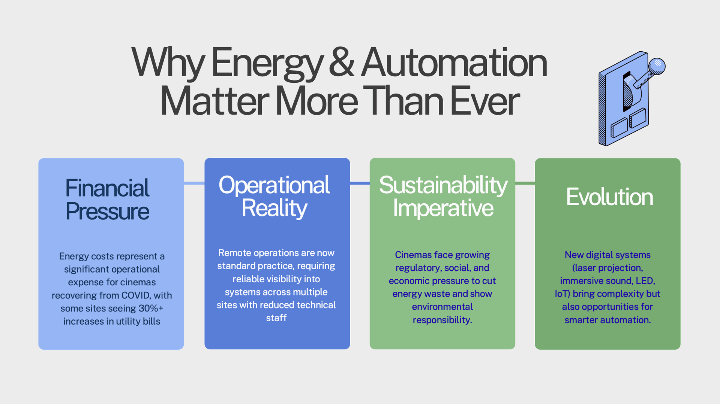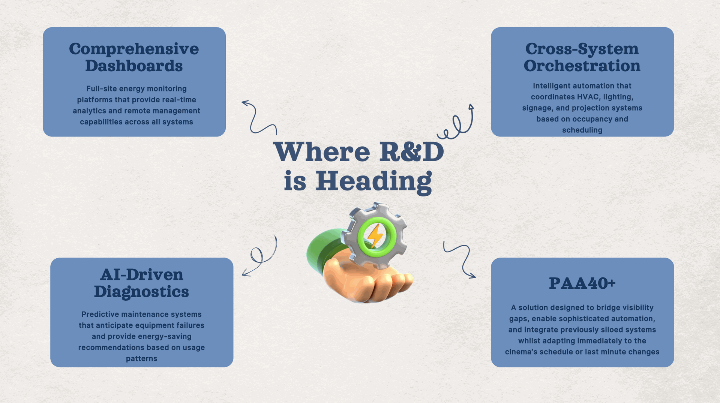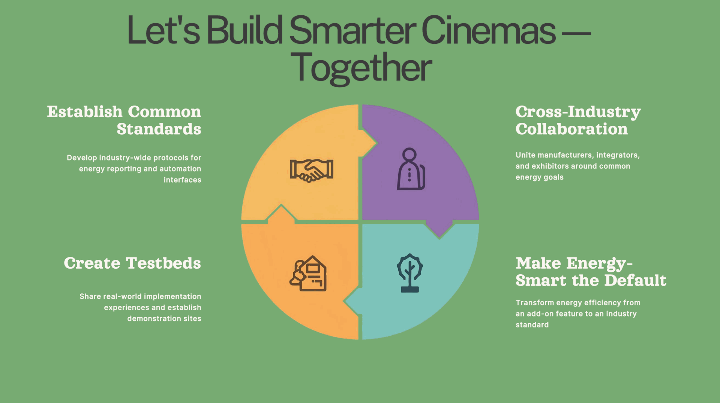Energy Monitoring and Automation in Modern Cinemas
This presentation by Araceli Vaello, VP CinemaNext Solutions, was delivered at the European Digital Cinema Forum (EDCF) Conference - IBC 2025 (Amsterdam) in September 2025. Below is a video and a transcript of the talk.
Araceli Vaello, VP CinemaNext Solutions at EDCF Conference in IBC 2025
"Thank you to the European Digital Cinema Forum for putting this together. Today I want to take you through one of the most urgent but often overlooked topics in this industry: energy monitoring and automation in our cinemas.
Why Energy & Automation Matter More Than Ever
Why does this matter so much today? There are four key drivers:
First, Financial Pressure: Energy has become one of the top three operational expenses for many exhibitors, with bills up to 30% higher compared to pre-COVID levels.
Second, Operational Reality: There are fewer staff available on all sites, and technicians are covering many sites simultaneously. If something goes wrong - like equipment being left turned on overnight - it may go unnoticed for days. It's very difficult to catch inefficiencies quickly.
Third, Sustainability Imperative: The pressure is coming from everywhere - regulators, new generations expecting change from us, and investors. If cinemas want to show environmental responsibility nowadays, reducing energy waste is one of the most important, clearest, and fastest wins.
Fourth, Evolution: New technologies are bringing opportunities, but without proper integration, these opportunities could create more inefficiencies instead.
The question isn't whether energy is important - it's how we can manage it wisely without giving teams that are already overloaded even more work.
The Technical Challenges We're Seeing
In our work across Europe and beyond as integrators, we often see the same challenges repeatedly:
Fragmented Infrastructure: Cinemas often operate with equipment from different eras and vendors that don't speak the same language - this is critically important.
Hidden Consumption Points: Air conditioning and lighting keep running under fixed schedules, even when there are empty spaces in the cinemas. Projection racks are often left running 24/7, consuming significant energy.
Legacy Equipment Inefficiency: Older systems don't help either, because many lack efficient standby modes. Even when not being used, they consume the same amount of energy as when actively operating - this doesn't make sense.
Isolated Automation: Where automation exists, it works in isolation from the rest of the equipment, managing just one piece of the puzzle instead of coordinating across all systems.
The tricky part is that most of these inefficiencies are completely invisible until the electricity bill arrives. That's the hidden cost of the complexity we're experiencing nowadays.

What's Missing Today
What are we missing in cinemas?
Actionable Data: Many operators cannot see real-time usage per auditorium or per device.
Comparative Analytics: There are no benchmarks - one site might consume 30% more electricity than another site, and no one knows why.
Smart Monitoring: Most systems are reactive rather than proactive. Lights are scheduled and air conditioning is fixed, but nothing adapts in real time to last-minute changes.
System Integration: Systems work in silos, none speaking the same language, so they cannot respond to changing conditions.
If we cannot measure it and coordinate it, we're not going to manage it wisely. What we're missing is essentially a brain for the cinema - and that's where we're heading.
Where R&D is Heading
The good news is we're making progress from an R&D perspective:
Comprehensive Dashboards: We now have available dashboards giving operators real-time visibility across sites and all equipment.
AI-Driven Diagnostics: We're working with predictive analytics and artificial intelligence - many companies can provide information and even predict failures before they happen.
Cross-System Orchestration: We're moving towards true orchestration where all equipment can work together, automatically adapting and aligning to showtimes and occupancy, turning on only what's needed when it's needed.
This is why at CinemaNext we developed the PAA40+ with all of this in mind. The PAA40+ is a smart automation and analytics device designed to monitor, control, and optimize energy usage, even in mixed environments with equipment from different eras.
But as we always say, talk is cheap - so let me show you a real-world example.

Real Case Study
I'll share results from one of the top five worldwide exhibitors where we recently installed a PAA40+, putting everything I've discussed into practice.
We installed the PAA40+ and power-metered just the amplifiers of an Atmos screen - 16 out of 22 amplifiers over several weeks. We followed the typical operator routine: an operator came first thing in the morning, turned on all equipment, and left the site at night turning off all equipment.
In the first graph, you see power consumption for a week. After this week, we connected the PAA40+ to the server (it could also connect to the TMS), so it could follow the cinema schedule.
Days to watch are the biggest bars - weekends and Thursday (spectator's day) - the days with the highest power usage.
The PAA40+ enabled us to:
- Monitor real-time power consumption from audio amplifiers
- Automate turn-on and turn-off sequences following the cinema schedule
- Do this in the correct order to avoid consumption peaks
Here you can clearly see the reduction. Let's examine Wednesday (spectator's day) in detail, as it showed the biggest energy consumption reduction.
Without PAA40+ (Wednesday 27th August):
- Operator turned on equipment at 11:00 AM
- Left it running all day until 00:50 AM when he left and turned everything off
- Total energy consumption: 20,207.45 Wh
With PAA40+ connected to server, following the same schedule (Wednesday 3rd September):
- 14:50: Equipment turns on before first session
- 16:15: Equipment turns off
- 18:36: Equipment turns on
- 21:36: Equipment turns off
- 22:15: Equipment turns on for last session
- 00:36: Equipment turns off after last session
- Total energy consumption: 12,892.54 Wh
Results
These results show a 36.2% reduction in overall energy consumption by comparing the same day with the same schedule - before connecting the PAA40+ to the server and after it was following the cinema schedule.
Comparing both graphs shows an overall weekly average of 20% reduction. This means immediate cost savings on monthly utility bills.
Most importantly, these gains required no major hardware changes - just intelligence and orchestration added on top of existing cinema equipment.
The lesson: it doesn't matter if it's a flagship cinema or local cinema, old or new - the potential for energy optimization exists. This wasn't about huge capital expenditure; it was about visibility and intelligent control.
What's Still Needed
Even with tools like this and successes like these, there are things we still need as an industry. Technology alone won't get us there - we need industry-wide effort:
Open Standards: Systems need to start speaking the same language
Secure Infrastructure: Secure and reliable remote access infrastructure
Vendor-neutral APIs: Exhibitors shouldn't be locked into specific equipment vendors
Staff Training: Technical teams need training to interpret data and act on it (we have an excellent technical training course at CinemaNext if anyone's interested)
Industry Commitment: Most important - we need to make smart energy practices and greener cinemas the norm, because this is the evolution of the future
This is much bigger than one product or company. It's about building smart cinemas together as an industry.

Building Smarter Cinemas Together
Let me wrap up with this thought: energy monitoring and automation isn't just about cutting costs today. It's about:
- Resilience in times of rising prices and tough economic conditions globally
- Sustainability for new generations with demanding audiences and regulators expecting this from us
- Future-proofing for the next decade of digital evolution
No single company can solve this alone. As I always tell newcomers to this industry - we're like a small family. We all know each other, and we can use that power to work together.
We need to share standards, establish pilot sites to understand how our equipment works and share results globally, develop open APIs, and foster collaboration between exhibitors, integrators, and manufacturers.
Cinema is evolving rapidly - we cannot face 21st century challenges with 20th century tools.
If we succeed, we won't just have cinemas that look and sound amazing (which is most important), but also cinemas that are smarter, greener, and more efficient.
Let's move forward together as the small family we are, making energy-smart cinemas not just a nice-to-have, but the new normal for everyone.
Thank you very much - I hope you enjoyed it.
Contact Information:
- Email: solutions@cinemanext.com
- Website: www.cinemanext.com
Energy Monitoring and Automation in Modern Cinemas